This is the enclosure for the amp:
2109 Full Aluminum HIFI Amplifier Enclosure Preamp Chassis / DAC Case / PSU Box | eBay
The finish is diy... CAD drawings and usage of my CNC router...
2109 Full Aluminum HIFI Amplifier Enclosure Preamp Chassis / DAC Case / PSU Box | eBay
The finish is diy... CAD drawings and usage of my CNC router...
My LJM L10 based amplifier
My LJM L10 based amplifier.
I need to change the transformer, this is limiting the power because it has only 240W. I will put in its place a toroidal 350W.
However, despite the weak 240W of the transformer, the sound is very good. So good I will use it instead of an Onkyo TX-8260 Receiver.
The power amplifier based on the LJM L10 has more bass power and has more midrange and treble.
Then Onkyo will go back to the packaging and possibly go to another owner. I really liked the sound of the DIY amplifier.
My LJM L10 based amplifier.
I need to change the transformer, this is limiting the power because it has only 240W. I will put in its place a toroidal 350W.
However, despite the weak 240W of the transformer, the sound is very good. So good I will use it instead of an Onkyo TX-8260 Receiver.
The power amplifier based on the LJM L10 has more bass power and has more midrange and treble.
Then Onkyo will go back to the packaging and possibly go to another owner. I really liked the sound of the DIY amplifier.
Attachments
-
 20191114_192555.jpg722.7 KB · Views: 888
20191114_192555.jpg722.7 KB · Views: 888 -
 20191114_192816.jpg607.9 KB · Views: 873
20191114_192816.jpg607.9 KB · Views: 873 -
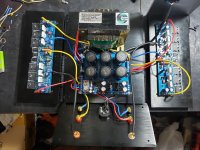 20191115_214003.jpg994.7 KB · Views: 854
20191115_214003.jpg994.7 KB · Views: 854 -
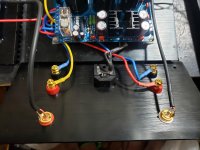 20191115_213952.jpg856.3 KB · Views: 837
20191115_213952.jpg856.3 KB · Views: 837 -
 20191115_215030.jpg999.3 KB · Views: 818
20191115_215030.jpg999.3 KB · Views: 818 -
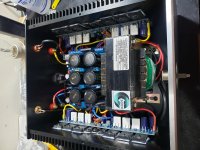 20191115_215038.jpg993.7 KB · Views: 418
20191115_215038.jpg993.7 KB · Views: 418 -
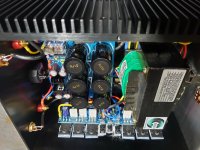 20191115_215051.jpg893.5 KB · Views: 382
20191115_215051.jpg893.5 KB · Views: 382 -
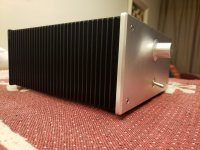 20191115_220153.jpg953 KB · Views: 315
20191115_220153.jpg953 KB · Views: 315 -
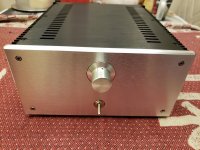 20191115_220200.jpg978 KB · Views: 294
20191115_220200.jpg978 KB · Views: 294 -
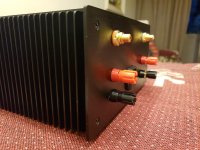 20191115_220239.jpg976.3 KB · Views: 315
20191115_220239.jpg976.3 KB · Views: 315
Last edited:
My LJM L10 based amplifier.
I need to change the transformer, this is limiting the power because it has only 240W. I will put in its place a toroidal 350W.
However, despite the weak 240W of the transformer, the sound is very good. So good I will use it instead of an Onkyo TX-8260 Receiver.
The power amplifier based on the LJM L10 has more bass power and has more midrange and treble.
Then Onkyo will go back to the packaging and possibly go to another owner. I really liked the sound of the DIY amplifier.
Vary nice job 🙂
Vary nice job 🙂
I have youtube video showing him playing in my speakers. Can I post here or is it against community rules?
Last edited:
I have youtube video showing him playing in my speakers. Can I post here or is it against community rules?
Go ahead!

So tiny heatsinks. does it keep the amp cool? those whould overheat my +/-58VDC class A/B amp whitin 1 hour just on idle.
So tiny heatsinks. does it keep the amp cool? those whould overheat my +/-58VDC class A/B amp whitin 1 hour just on idle.
Yes, the amplifier is ok. So far, heat sinks have been shown to be adequate.
The amplifier is working with 42VDC and 6 ohm speakers. I don't hear music at high volume so the amplifier doesn't heat up that much.
Yes, the amplifier is ok. So far, heat sinks have been shown to be adequate.
The amplifier is working with 42VDC and 6 ohm speakers. I don't hear music at high volume so the amplifier doesn't heat up that much.
So with 42V rails, it's more like a 50W amplifier on 8 Ohm ?
.
The enclosures? Where did you get them, or are they DIY?
Regards Johnno
We have a branch of the Italian Modushop store in Poland. DIY - nasze prace - panele przednie - Sklep modushop.plThey sell ready-made audio enclosures and provide comprehensive services (subtitles + CNC milling). I recently ordered them to make my project in accordance with my guidelines. Delivery time is 1 month. So if someone lives close to my country, I recommend it. I am not affiliated with this company in any way but they actually do well. In a while I will also show off my project which is being implemented and I plan to finish it in spring 2020 It will be Dac 2 system opam / tube + hybrid amplifier called "Pana-Mera". Greetings to all🙂:RE.
So with 42V rails, it's more like a 50W amplifier on 8 Ohm ?
.
I measured the power yesterday and got 73W at 8 ohms, but for now I use a small 240W transformer, soon I will put a 300W or 350W.
I measured the power yesterday and got 73W at 8 ohms, but for now I use a small 240W transformer, soon I will put a 300W or 350W.
I see. So what is the rated output power for this amp ? I am guessing 100W then ? I am also wondering about the seemingly small heat sink fins. They do appear a little inadequate.
How much power does this amplifier consume in idle per channel ?
I see. So what is the rated output power for this amp ? I am guessing 100W then ? I am also wondering about the seemingly small heat sink fins. They do appear a little inadequate.
How much power does this amplifier consume in idle per channel ?
The amplifier board has power specified at 100W @ 8ohms and 200W @ 4ohms.
As I said, my power transformer greatly limits the total power of the amplifier as it only has 240W.
The quiescent current setting is 60mA on each channel.
Then I can measure the temperature in the sinks, but really, at the volume levels I use they get hot but nothing to worry about.
My Onkyo TX8260 Stereo receiver heats up even more without signal at the input.
I see. I guess each channel is dissipating about 5W in idle. By just eyeballing the heat sinks you have, I am estimating that at most they can dissipate 40W or so.
That is fine for your normal listening volume, but when you measure the rated power this will likely overheat on short notice and might require forced air cooling to help a bit.
That is fine for your normal listening volume, but when you measure the rated power this will likely overheat on short notice and might require forced air cooling to help a bit.
I see. I guess each channel is dissipating about 5W in idle. By just eyeballing the heat sinks you have, I am estimating that at most they can dissipate 40W or so.
That is fine for your normal listening volume, but when you measure the rated power this will likely overheat on short notice and might require forced air cooling to help a bit.
So there's something wrong with all this because when I measured the power, I used a 1KHZ sinusoidal signal and the heat sink got hot, but not to the point where I couldn't touch it with my hands.
During the auditions, it is only warm, except one day when I decided to turn the music on loud. On this day he got very hot but nothing that worried me. I found the temperature quite normal considering being an AB amplifier.
Anyway, I will exchange the power transformer for one capable of providing 350W.
Maybe with this 350W power transformer the heating will be too high?
Below the specifications of each heatsink..
Heatsink Dimensions: 110mm x 260mm, thickness is 7mm,
Each heatsink has a net weight of 0.8 kg.
Last edited:
I see. I guess each channel is dissipating about 5W in idle. By just eyeballing the heat sinks you have, I am estimating that at most they can dissipate 40W or so.
That is fine for your normal listening volume, but when you measure the rated power this will likely overheat on short notice and might require forced air cooling to help a bit.
So there's something wrong with all this because when I measured the power, I used a 1KHZ sinusoidal signal and the heat sink got hot, but not to the point where I couldn't touch it with my hands.
During the auditions, he gets warm, except one day when I decided to turn the music very loud. This day he got a lot hot but nothing to worry about. I found the temperature quite normal considering being an AB amplifier.
Anyway, I will exchange the power transformer for one capable of providing 350W.
Maybe with this 350W power transformer the heating will be too high?
Below the specifications of each heatsink.
Heatsink Dimensions: 110mm x 260mm, thickness is 7mm,
Each heatsink has a net weight of 0.8 kg.
Heatsink temperature will change if the transformer voltage is raised, but not with higher current available. The heatsinks look like they should actually be fine for a moderately powered amp if run at reasonable output levels. Full output testing would be a different issue but we don't normally listen to sine waves at high output levels.
Last edited:
Heatsink temperature will change if the transformer voltage is raised, but not with higher current available. The heatsinks look like they should actually be fine for a moderately powered amp if run at reasonable output levels. Full output testing would be a different issue but we don't normally listen to sine waves at high output levels.
The voltage will remain the same. Only the current will have an increase of 110W.
- Home
- Amplifiers
- Solid State
- Post your Solid State pics here
